- Established 1982 -HOME: www.hiltonpond.org
THIS WEEK at HILTON POND Subscribe for free to our award-winning nature newsletter (Back to Preceding Week; on to Next Week) |
A RARE FOREIGN RECAPTURE, Perhaps the most exciting happening this winter at Hilton Pond Center came on 3 February 2021 while we were checking traps. After handling 328 Pine Siskins (PISI) October through December 2020, we had very few recaptures--suggesting most moved on after partaking of the Center's copious seed supply. Starting in January, however, we began getting a lot of same-day and same-week recaptures--i.e., banded siskins were hanging around--so we were careful to examine the numbers on each bird's band to see when it was originally caught.
All text, maps, charts & photos © Hilton Pond Center On the morning of the 3rd we extracted a Pine Siskin (PISI) from a trap and noticed its aluminum band was a bit dirty and dull rather than bright and shiny like the ones we'd recently applied. An old band would be of interest because we've had only a couple Pine Siskins return in subsequent winters. In the old days when one found a banded bird and submitted "foreign recapture" info to the federal Bird Banding Lab in Laurel MD, it could take weeks to get a response about when and where the bird was originally captured. These days, thanks to the Internet, one just goes to the BBL's Band Report web site, enters a band number, and gets an immediate reply; assuming the bander has already submitted banding data, the Web site provides basic information. That's exactly what happened for us when we typed in the foreign siskin's number:
All text, maps, charts & photos © Hilton Pond Center According to Web results (above), the Pine Siskin we recaptured was banded as a "youngster" during its hatching year on 1 November 2020 near Kingstown, Maryland--which immediately caught our attention. We went straight to Google Maps and learned Kingstown is just across the river from Chestertown, a location of some interest because a bander from there named Jim Gruber had recaptured TWO American Goldfinches banded at Hilton Pond. Further investigation showed Washington College in Chestertown runs Foreman's Branch Bird Observatory in Kingstown (see map below); this knowledge, in turn, led to some Facebook messaging with field ecologist Maren Gimpel--who turned out to be the person who actually banded the siskin in question at her locale--about 412 straight-line air miles from Hilton Pond Center!
All text, maps, charts & photos © Hilton Pond Center Maren told us she and four others at Foreman Branch caught 896 Pine Siskins last fall through November 2020--even more than we handled at Hilton Pond Center--but that they do very little winter banding. She verified they had taken measurements of their siskin (including a wing chord of 67mm) and had aged the bird as hatch-year but had not sexed it. Since we also got a 67mm wing measure at recapture, one of our references indicated it is safe to call this bird a female because male Pine Siskins have wing chords longer than 67mm. All text, maps, charts & photos © Hilton Pond Center Although our encounter with this "foreign" Pine Siskin occurred on 3 February, we waited to write about it until this week when we received a formal "Certificate of Appreciation" (above) with more details from the Bird Banding Lab. (Anyone who reports a banded bird can get one of these documents--suitable for framing and hanging where one can brag about it! Duck hunters who legally shoot banded waterfowl in season often have dozens of certificates hanging on hunting lodge walls.)
All text, maps, charts & photos © Hilton Pond Center Recapturing this Pine Siskin banded in Maryland was exciting for several reasons. For one, it's always fulfilling to capture a bird first handled by another bander, knowing every such data point gives us a better understanding of bird movements. Second, at the Center we very seldom capture such birds banded by someone else; in fact, this PISI was just the tenth individual at Hilton Pond banded elsewhere--and ALL have been finches! (During 40 years, that's five Purple Finches, three House Finches, an American Goldfinch, and this latest Pine Siskin.) But, for us the most amazing aspect of our siskin encounter is that--as mentioned above--the bird came from Foreman's Branch Bird Observatory, where TWO of OUR banded goldfinches were recaptured and released in 2010 and 2011. Does that mean there's some sort of flyway between York SC and Chestertown MD, or do the two sites have some sort of serendipitous avian exchange program?
All text, maps, charts & photos © Hilton Pond Center One thing we know for sure: The foreign Pine Siskin we caught here at Hilton Pond Center wasn't really FROM Maryland, simply because siskins don't nest that far south. The vast majority breed in Canada (see map above), with the Maryland bird more likely to have originated in northern Maine or the Canadian maritime provinces. It's very interesting, then, that Maryland was merely a stopover for this long distance migrant that undoubtedly refueled at Foreman's Branch before heading for Hilton Pond. Was the Center her final destination for Winter 2020-21, or did she depart our site en route to somewhere even further south . . . or west . . . or who knows where? We'll never find out for sure, of course, unless someone else encounters this Pine Siskin elsewhere, but we did determine this wandering siskin was a bit of a "trap junkie." After recapturing and releasing her on 3 February, we caught her the next day--and then again on the 11th and 12th. Perhaps she's spending her final winter weeks here, but maybe it means she's likely to be caught again after she leaves Hilton Pond. What would be REALLY phenomenal would be for Maren Gimpel and the Foreman's Branch banders to see #2910-19509 once more--on the siskin's journey back north this spring. All text, maps, charts & photos © Hilton Pond Center HILTON POND SISKINS ENCOUNTERED ELSEWHERE Along with those ten winter finches banded elsewhere and encountered at Hilton Pond, another 65 birds from here at the Center have been recovered or recaptured outside our home base of York County SC. Most have been the among four "winter finches": Purple Finch (18 foreign encounters elsewhere), House Finch (17), American Goldfinch (9), and Pine Siskin (5), for a total of 49.
All text, maps, charts & photos © Hilton Pond Center Particularly noteworthy among the five siskins (see map above) were two banded at the Center a year apart (1987 and 1988) and recaptured an hour apart at Duluth, Minnesota (1988; ~990 straight-line miles). Two others were found dead in Apsley, Ontario (1985; ~700 miles) and Pittsfield, Massachusetts (1988; ~670 miles), while the fifth was stunned as a window strike but released at Schomberg, Ontario (1992; ~640 miles). All text, maps, charts & photos © Hilton Pond Center (Click on chart above for a larger version in a new browser window) It's worth pointing out all five foreign encounters of banded Pine Siskins from Hilton Pond occurred 29 years or more in the past. One partial explanation is that in 17 winter seasons from 1991-92 through 2007-08 we banded a total of just 58 PISI (see chart above), and during most of those winters we actually banded none--greatly lessening the probability someone far away would encounter one of our birds. Oddly, in the irruptive winters of 2008-09, 2010-11, 2012-13, and especially 2014-15 we captured substantial numbers of siskins, but none were reported elsewhere. It will be interesting to see whether our current record-smashing Pine Siskin winter with 1,133 bandings through 28 February yields any long-distance encounter results. NOTE: In what undoubtedly was the most productive two-month period in 40 years of work at Hilton Pond Center, during January and February 2021 we averaged 21.81 bandings PER DAY among all 16 species handled! We might have had more, but on at least a dozen days we did not band because of stormy weather or other factors. (We averaged 13.6 Pine Siskins daily during the 59 days--an irruption for sure.) All text, maps, charts & photos © Hilton Pond Center THINK IT'LL RAIN? Although we don't normally deploy mist nets in rainy weather, some days in February were so torrential we couldn't even use ground traps to catch birds at Hilton Pond Center. Seeds we spread for bait simply floated away, and traps ended up mired in inch-deep puddles--not a healthy situation for birds (or banders). Even the hanging traps were mostly unusable, since birds in them got soaked pretty quickly if ensnared during a downpour. So how wet is it? Last year (2020) we set an all-time record for precipitation at Hilton Pond Center with an incredible 61.75" in our Ambient digital rain gauge--nearly all rain but with a few snowflakes mixed in during cold months. Compare that to an annual average of about 44" for the past 40 years and you can understand why slippy, sloppy, soggy, and muddy were appropriate words on many days during 2020.
All text, maps, charts & photos © Hilton Pond Center The current year is more of the same so far, with waterlogged folks 'round these parts claiming they are beginning to grow gills and webbed feet as gray skies abound and rainfall pelts us day after day. January 2021 brought 4.60" of precipitation, followed by another 5.91" in February, for a substantial two-month total of 10.51"! The ground is absolutely saturated, and even a light drizzle creates run-off where the soil can absorb no more moisture. One result of all this rain is Hilton Pond is as full as it can be without overflowing at the spillway; the photo above taken on 28 February shows water lapping at the bottom of the pier. Some winters the tethered float at right is at--or well below--the same level as the pier itself. In our drought-year image from November 2016 (below) the float is actually resting in muck on the bottom of the water-starved pond--not a good situation for fish, turtles, or riparian plants dependent on an impoundment diminished to a third its normal surface area.
All text, maps, charts & photos © Hilton Pond Center In the past few winters abundant rain has indeed kept Hilton Pond at or near full until the arrival of spring when frogs are courting and fish are spawning. This is an especially beneficial situation because when summer gets here pondwater evaporates quickly during long, hot days, drawing down the impoundment--sometimes faster than one might expect. If no significant summer rains occur, much of the pond becomes a mudflat unusable by most plants and creatures that call the Center home. As of the end of February it doesn't look like that's going to be a problem for 2021, what with the pond at full stage and its squishy banks saturated. All text, maps, charts & photos © Hilton Pond Center SUNSETS AT HILTON POND "Never trust a person too lazy to get up for sunrise We announced recently we would attempt to take a photo of the sunset every day in 2021 as a way to document changes in weather and the seasons--and to show our aesthetic side. We heard from numerous folks encouraging us to include such images in installments of "This Week at Hilton Pond." This we are happy to do.
All text, maps, charts & photos © Hilton Pond Center Sunset over Hilton Pond (above), 19 February 2021 Photoshop image post-processing uses DeNoise AI, Sharpen AI , and other Topaz Lab tools
Checks also can be sent to Hilton Pond Center at: All contributions are tax-deductible on your Don't forget to scroll down for Nature Notes & Photos, |
|---|
|
"This Week at Hilton Pond" is written and photographed by Dr. Bill Hilton Jr., executive director of Hilton Pond Center for Piedmont Natural History
|
|
|
Please refer "This Week at Hilton Pond" to others by clicking on this button: |
|

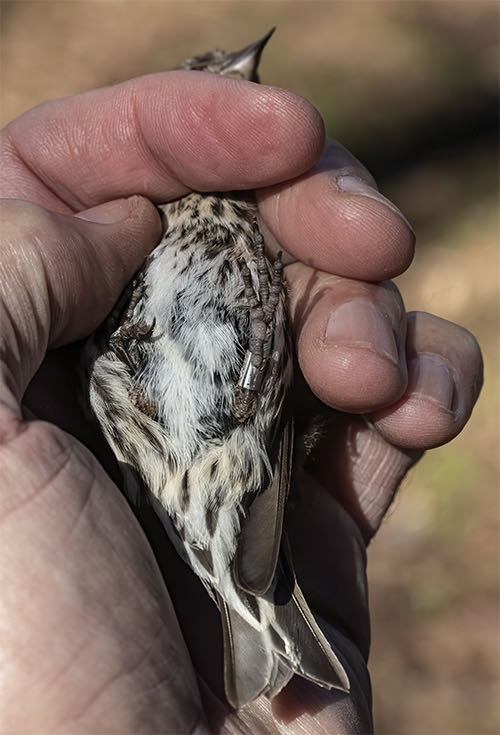
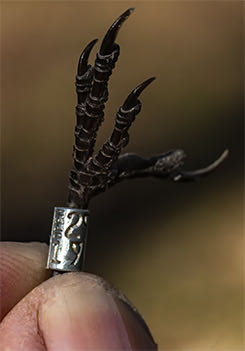 However, when we read the band number
However, when we read the band number 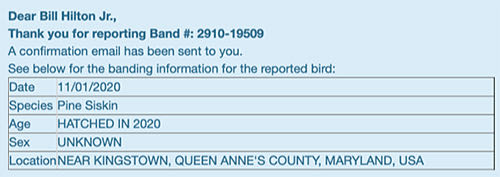
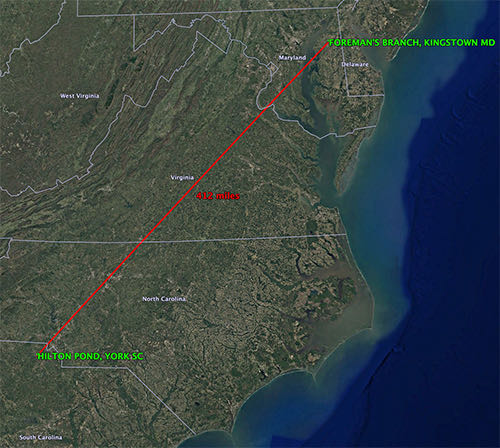
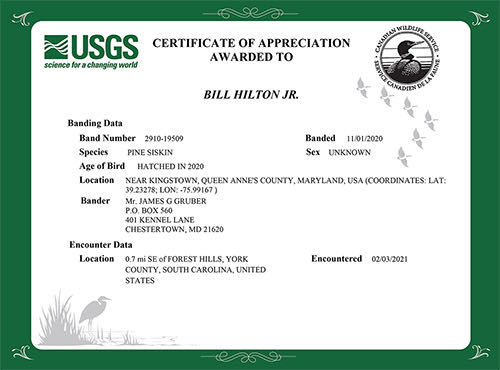
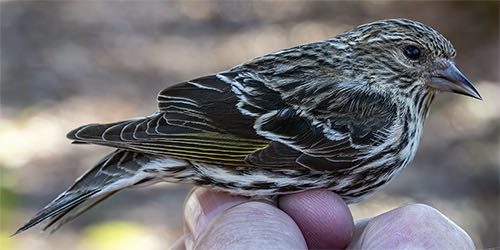



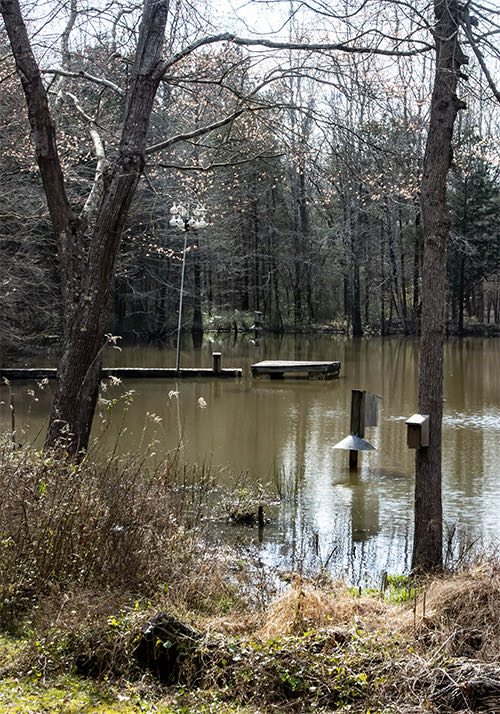
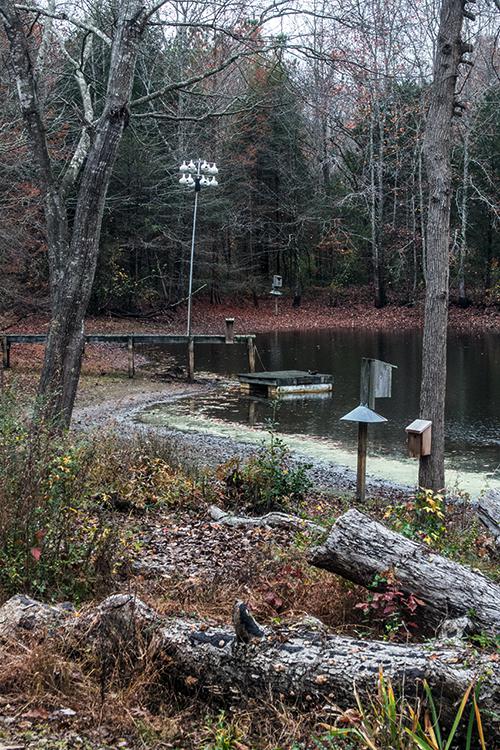
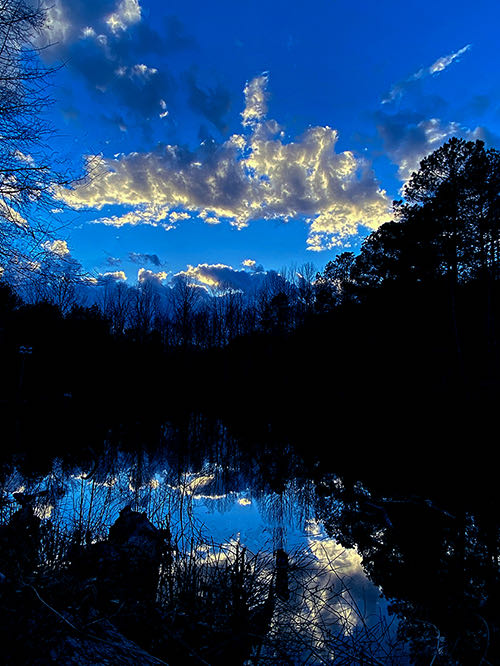










 Oct 15 to Mar 15:
Oct 15 to Mar 15: